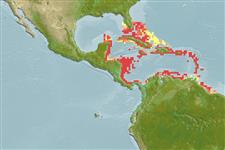Common names from other countries
Environment: milieu / climate zone / depth range / distribution range
Ecologia
Associadas(os) a recifes; intervalo de profundidade 0 - 23 m (Ref. 83922). Tropical; 28°N - 6°N, 89°W - 55°W (Ref. 4)
Western Atlantic: Caribbean Arc from Cuba to Trinidad, Los Roques.
Length at first maturity / Tamanho / Peso / Idade
Maturity: Lm ? range ? - ? cm Max length : 20.0 cm TL macho/indeterminado; (Ref. 271); common length : 15.0 cm TL macho/indeterminado; (Ref. 4)
It has lengths of 20 cm, maximum total body length; 15 cm, common length (Ref. 4). Maximum depth range from Ref. 122059. Exclusively inhabits coral reefs (Ref. 106828). Also occurs in shallow waters and inhabits rocky areas, mainly in crevices (Ref. 4), seagrasses and rubble (Ref. 97531). Nocturnal omnivore (Ref. 106982).
Life cycle and mating behavior
Maturidade | Reprodução | Desova | Ovos | Fecundidade | Larvas
Members of the order Decapoda are mostly gonochoric. Mating behavior: Precopulatory courtship ritual is common (through olfactory and tactile cues); usually indirect sperm transfer.
Holthuis, L.B. 1991. (Ref. 4)
Status na Lista Vermelha da IUCN (Ref. 130435)
Status no CITES (Ref. 108899)
Not Evaluated
Not Evaluated
Uso pelos humanos
Pescarias: espécies comerciais
| FishSource |
Ferramentas
Fontes da internet
Estimates based on models
Preferred temperature
(Ref.
115969): 26.7 - 28.3, mean 27.6 (based on 331 cells).
Vulnerabilidade
Low vulnerability (10 of 100).
